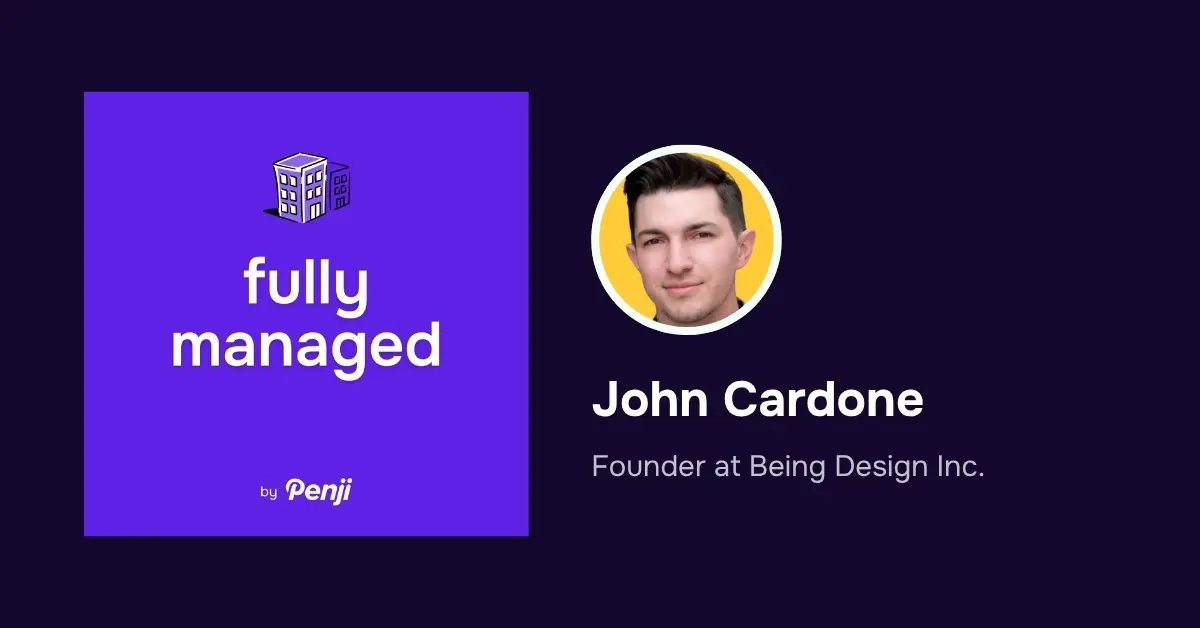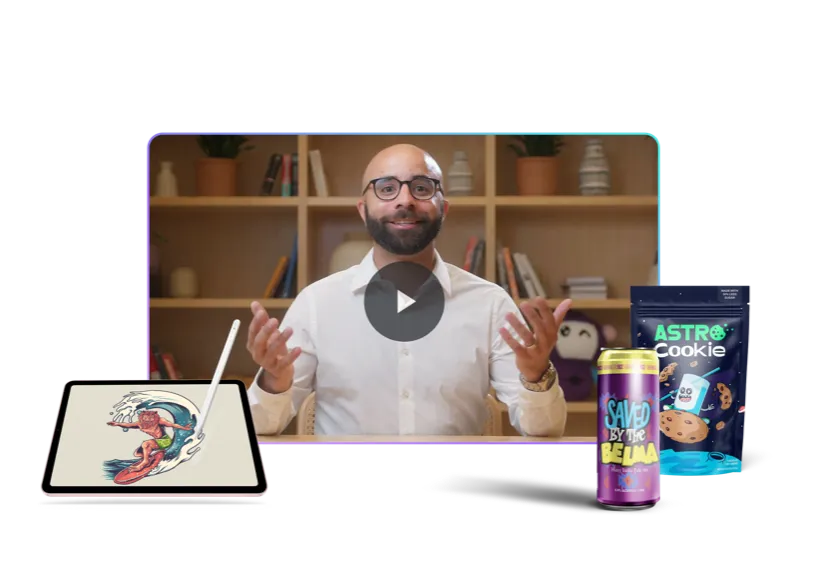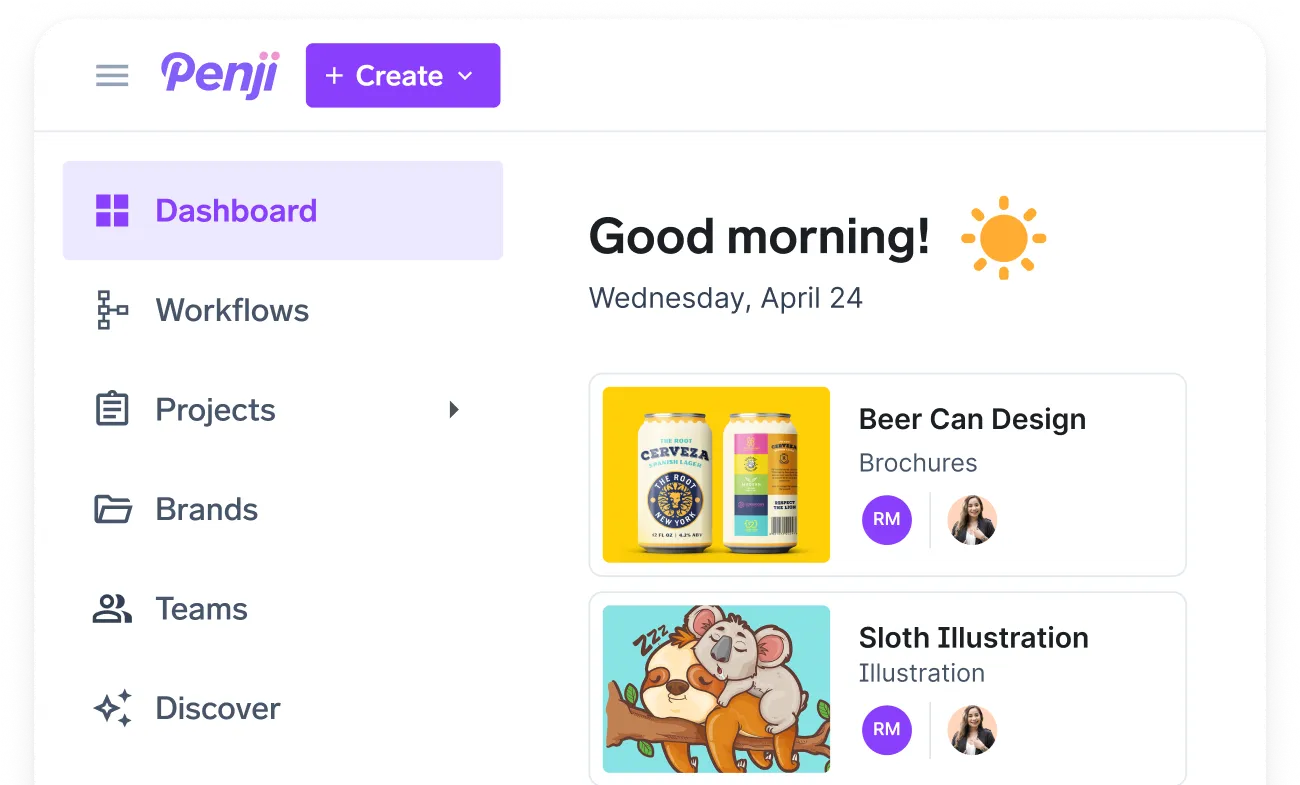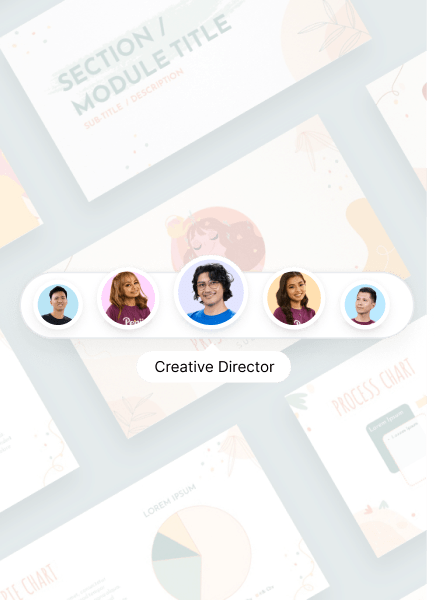
Introduction
Shannon Donnelly (SD): Alrighty. Hello, everyone, and welcome to the Fully Managed Podcast, the podcast where we discuss marketing and business tips to help assist you on your business journey. I’m your host, Shannon, Penji’s Partnership Coordinator, and I’m joined here today with a very special guest, John Cardone from Being Designed. Thank you so much for coming out with me today.
John Cardone (JC): Yeah, thanks for having me, Shannon. I appreciate it.
SD: So could you just start by telling us a little bit about yourself, kind of how you got to this point in your career and anything you think that is relevant to the audience up until then?
From Fine Art to Freelance
JC: Yeah, sure. This is, I mean, this is a story I tell pretty often, not necessarily on stages or anything, usually just when I’m meeting people and they’re asking me like, you know, how I got into this. So I went to art school. And art school, I think for some people could be a good choice. I think a lot of people that get pushed into art school, it’s often a bad choice. And I think that especially if you study fine art, I think a lot of people that study fine art like myself would have been better off doing kind of like an applied creative field. But anyway, I went to school for fine art. And so I did not just an undergraduate in fine art. I also did like a year and a half of grad school. I didn’t finish it because I decided not to, but I was kind of working in the art world even before I graduated. And I was, I was pretty ambitious at the time. But after maybe like three or four years of really being part of the art world, I made a decision that I did not want to continue the field of fine art that I was much more interested in, you know, contributing to society, contributing to a community, contributing to, you know, I hope to have a family in the future. And so I decided I was much more interested in doing that through business. So I tried to make like a full one eighty and get a job. And nobody wanted to hire me because I had this wacky fine arts degree and like a cool CV and kind of resume, but not if you were just trying to get a normal job. So really frustrated after almost a year of trying to get a good job, I couldn’t get one. And I got this kind of temp job at an art gallery and at the art gallery they needed to build a website because they wanted just to promote their art gallery but also sell some of the works online so you could look at all the paintings they had and buy them. They had hired some agency down the street for like, I don’t know, like five or six thousand dollars to do it. They did a really bad job and in the end like it wasn’t publishable like the boss felt like they wasted all this money they couldn’t do anything. And so me, like, you know, on the downtime at the job while there’s no one in the art gallery, they’re like, you tinker and see if you can maybe figure some stuff out. And I basically rebuilt their entire Shopify site. I taught myself the Shopify coding language liquid by reading through the forums and stuff and the documentation. And then by like a month later, I had rebuilt the entire site from scratch. It was super functional. It was better than the product that they were going to get from the other agency. And I realized that I was about to hand over something like at least five thousand dollars worth of work that I was getting paid like twelve dollars an hour for. So I was like, well, this doesn’t make sense. So I told my wife and I told my boss that I was quitting because I had gotten accepted into a freelancer’s collective. I just made this up and I mean, I was the freelancer collective. And then now, so a little aside, I had been building like art portfolio websites all through school to kind of pay my way through school. I had a number of really weird odd jobs and one of them was building websites for my professors, for people I met through the art world, for grad students, anybody else, for like events that we would put on. So I had already built a couple dozen websites at the time, but they were all like really simple, nothing like kind of a transactional site like Shopify. So I felt like I could kind of back this up. So I said, okay, I’m quitting. I’ve been accepted into this freelancers collective, but you can hire me back not for fifteen dollars an hour, not twelve dollars an hour, which you were paying me, but for fifty. And I thought that was like a huge jump. But for her, she was like, oh, that’s great. Yeah, I’ll hire you right now. Finish this website. We need it. So I spent the next week I used to work at finishing the website and I published it. And then she gave me a great review. And that was my first like client job, as a professional. And so a few months later I incorporated, and I started what at the time was a web design company. I didn’t really know the difference between like web design development and marketing and branding and an agency versus consultants. I didn’t know any of that. I just knew that I could build websites and figure stuff out. So that was how I got my start. And the reason that I did, I did that. And I couldn’t wait is because I had proposed to my longtime girlfriend and I really wanted to get married. But her parents told me that I needed to pay for half of the wedding. And so I started a web design company really just to pay for a wedding. That was why.
SD: That’s kind of sweet though. I mean, like I’m assuming since you’re still doing it, that you enjoy it. And so that it’s not just for a singular purpose.
JC: Yeah, I mean, it played to my skill sets. It played to my strengths and also to my weaknesses, I guess. But I think it also is reflective of the way I’ve built the rest of the business, which is that I didn’t have dreams of building the world’s best web design company or design agency. I had maybe like a more personal kind of deeper goal, and this was a way to get there. But then, you know, the reason that that works is because when my clients hire us, we are not the highlight of their year. It’s not like they can’t wait to work with us. They’re hiring us so that they can achieve some other goal. And we are instrumental in that way in helping them get closer to the goal in the same way that I was getting closer to my wedding. So it’s not a problem. It’s actually been more helpful than if I was just out to make like, you know, some kind of idealistic version of an agency.
SD: Yeah, no, I think that makes a lot of sense because I think that a lot of people are looking for that idealistic format, I suppose. But if you’re just goal oriented and, you know, you have a reason to do this job well, other than just doing that job well, then I mean, that kind of propels you to get it done.
JC: Yeah, yeah, yeah. So that end after, so after like then the wedding went over and then I had a friend of mine who was doing something similar. So we decided to team up and then, you know, like co-run the thing. And then we, our first goal was accomplished. I paid for a wedding and now I was like, you know, off to the races, but we didn’t have another goal. So then we fell into this weird, like idealistic dreamy quagmire and we didn’t know what we were doing. We made a ton of really bad mistakes. Barely made any money that in that calendar year. He and I ended up parting ways professionally, although we’re still very good friends. And then like, you know, down the road a little ways, my wife and I wanted to have a child and like, we looked at our finances and we were like, oh, like this is not going to work. Especially if you take time off work and don’t go back to work, I basically need to double the revenue. And so I had just been kind of lollygagging for like a year and a half or two years. And then suddenly, because there’s another goal, we doubled revenue super quick. Once there’s an actual need, that happened.
SD: Yeah, I mean, no, that’s I mean, that that I think that works for a lot of people. And I don’t think that’s really a bad thing. I need goals regularly in order to actually do anything. I have to like make lists for mundane tasks in order to get them done. And I don’t think that that’s like, I don’t think that’s a bad thing. I think some people just need to like set goals. Like you need to have a reason to do something other than just being, I don’t know, just for doing it. A lot of people just do just to do. And I don’t understand that. I’ve never understood that mindset.
JC: Yeah, no, I agree. And it, you know, again, even it sounds kind of comical and it always makes a good joke when I’m telling people my story. But it also has gone over very well with clients because it’s very relatable for clients. Again, they’re not like they’re trying to accomplish a goal. And being transparent about kind of the motivation structure, how things got started. A lot of the people that makes them trust you more because they’re like, well, A, he’s willing to say that. And then B, he understands this idea of problem solving for a goal.
SD: Yeah, I think it’s also like, you have more on the line, kind of. I think that a lot of, I guess, like, I don’t know, I wouldn’t say a lot, I just, there are agencies that don’t have that perspective because, you know, they’re at a certain bracket where they’re kind of just floating, I guess, and I think that that doesn’t necessarily make you want to do better. I think it’s kind of similar to like those companies that have been around for so long. And the only reason that people still use them is because of like brand loyalty.
JC: Yeah. Yeah. I mean, there is a lot of that. There’s like, you know, the whole that example, like nobody ever got fired for hiring IBM. Like if you, if you make a corporate hire, you say, okay, we’re going to contract IBM. It’s like, that sounds safe. Cause everybody does it. Even if it’s a huge waste of money, there’s a lot of that kind of blind loyalty. And like probably a lot of your listeners or probably a lot of the other people you’ve had on podcast on this podcast, starting from probably zero or starting from almost zero, you have the opposite of brand loyalty, right? You’re a total newcomer.
SD: Yeah. more wary. But you know, I think that there’s a level of trust when you have goals of your own, I guess people are able to and you’re honest about them. I think that that definitely builds a level of transparency to which is really important in the agency role for people to be successful.
JC: Yeah, go ahead.
SD: Oh, sorry. I was going to say, so I was at Switch Topics because I’m curious. Okay, so you started kind of just doing this just because it was like your skill set. And I’m assuming that you started in the art world because I’m sure you had some connections there. But you seem to have fallen into or purposely gone down the avenue of purpose-driven founders, which I see a lot on your website. How did you kind of navigate to this kind of client and what, how do you identify if this is the right person that you want to work with?
Purpose-Driven Founders and Values Alignment
JC: Yeah. Yeah. And it’s a great question. I love talking about this. So even though I laid out this one narrative of me being pragmatic and goal oriented, on the other hand, I come from the art world and I went to art school. So I’m hopelessly unrealistic in some ways and very naive in plenty of ways. And so, and even like the kind of work I was doing when it was in the art world, I was doing like public funded art, community based art, community based placemaking, social practice stuff, stuff kind of like what, the Philadelphia mural arts, like what the whole program does, you know, stuff of that vein.
SD: I actually just interviewed the marketing director. I love them so much.
JC: No, no, they do really great work. So I was really steeped in that culture and that world of, again, wanting to do good and saying, well, if we’re going to do this thing anyway, let’s at least align it or point it towards something that has some kind of long-term social impact. And so because that’s who I knew at the time, and I knew people in art and culture nonprofits for the most part. I did know people in the art world, but I think more precisely, I knew people in arts and culture nonprofits, which they themselves are a very idealistic group of people. So I mean, just to again, like trying to solve the problem and solve the goal. On the one hand, I felt this need to like I wanted to be excited about the work I was doing because I had a clean slate. There’s another way of framing that question, which is a lot of times businesses come to me like they’ve been in business, ten years, fifteen years, twenty, twenty-five years even. I have worked with some businesses that have been around for fifty years. And they were able to grow kind of organically to a point, but which was basically their network, like personal relationships disguised as business relationships, but it’s really just personal relationships. And they weren’t ever too reach a new a wholly new audience who would then become loyal based on impression based on brand, right? They’ve not been able to do that. And I said what and they say yeah we’re frustrated with five years and we can’t grow into a new audience. Okay this is why. The reason you can’t go into an audience is because you’re relying on human beings and personal connections to make all of your brand promises for you. You haven’t codified your brand promises and your values into the actual brand, marketed brand. And so then when I frame it to them that way, that convinces most people. And I’ve only ever had one client that disagrees with the concept and didn’t want to do it. But I’ve had several clients that just disagreed with the budget. And they said, well, we can’t put these resources towards it, even if they are.
SD: Okay, so you’re explaining that there’s situations in which you kind of have to tell a client that they need to have values oriented marketing approaches, basically.
JC: Yeah. Yeah. I would say, you know, ninety ninety five to ninety nine percent of our business is referral. So we actually don’t even do that much marketing for ourselves. And in the referral process, people will come to us and say, hey, we heard that you guys do this thing. And now they’re kind of turned on to the idea. But some people, they say, oh, we just need a website. And someone said, you guys are good at websites. So I need a website. And then I say, well, why do you need a website? It’s like, well, because I need to break into a new audience. I say, okay. And then we go down this line of questioning. And eventually, they come up to this. They come against this wall. And then some people say, Well, I think the real problem is, I’m just not getting my name out there. I think I need to do pay per click advertising, I think I need to do this, I say, Okay, so we’re going to put this ad up, why are people going to click on it. And then we come right back to this idea of values connection anyway. And, like, I think that a lot of people, when I use the phrase values alignment, they think that I’m introducing a new concept. I think that most good marketing does values alignment even if it’s unaware that it’s doing that. I think that one of the marks that you’ve been successful is that you’ve accidentally or intentionally stumbled upon values alignment.
SD: I definitely agree with that. I think there’s a lot of brands that have that, that you don’t even realize, but you have, they kind of leave a good taste in your mouth because they have some kind of particular stance on something. For example, like Warby Parker gives a pair of glasses to someone in need of glasses every time you buy a pair of glasses or like Tom’s with the shoes.
JC: Yeah. And like Warby Parker, it’s a great example. The promise of Warby Parker is you shouldn’t have to spend a lot of money to look good. That’s the promise. That’s the belief statement of Warby Parker. And then they deliver on that. And then it turns out that like they apply. you know, models that are in other businesses and they apply that to eyewear where you’re like, wow, this is the most pleasant experience I’ve ever had buying a pair of glasses. Usually it sucks. And you guys, and so then they, they back that up, you know, with layers and layers of experience and then that becomes marketing as well. Yeah, I, I totally agree with that example.
SD: Yeah, exactly. So I definitely think that some of the best brands are already doing that. And sometimes even not even larger brands like the examples that I gave, but other agencies are just doing that.
Minimizing Friction in Agencies
JC: Your profit margin, I think is on the one hand tied to, you know, how efficiently you work and like, you know, the, the pricing and all that. But on the other hand, it’s tied to not screwing up and not digging holes for yourself. Because if you get the wrong client in the wrong situation at the wrong time with the wrong values, someone that you, it turns out you don’t actually work well with them. They don’t work well with you. All of this friction completely obliterates your profit margin and sustainability. And so I think a lot of agencies, you know, they’re they’re doing okay. And then if they look back at the book of business over the last year, they go, there was a lot of friction, though. I mean, imagine if we had removed that friction. Would that have made more profit or just a more pleasant experience or more free time? And so, you know, sometimes you can even give up a little bit of top line revenue for the sake of having less friction in all of your working relationships. Because, again, if you’re a small agency, especially if you’re a full service agency, you know, friction is the enemy number one.
SD: Yeah, and if your workers don’t like working because of the type of clientele that you have, that’s not really a good balance either, especially when you have a smaller agency and you depend on these people. Even if they choose to stay in that situation, you have a lot of burnout and maybe now they’re not doing their best work that you hired them to do that they’re capable of doing. They just don’t want to, don’t have the motivation to when working with a specific type of client. I think that’s like a really important thing to consider when going through picking clients or accepting them, because everyone needs to work well together too. It’s not just producing good work. There’s so many factors that go into producing good work and outside of just ability.
JC: Yeah, no, I totally agreed. And I think, yeah, it helps if you clarify what you’re setting out to do early on. Like, are you trying to grow this agency to the max or are you trying to provide the best experience for clients that you really care about? And if your vision is more modest like that, like I’m trying to provide the best experience for clients I really care about and we wanna do really good work. Well, yeah, then if that’s the case, then I recommend like dialing up that factor of friction or value or the lack of friction because of your values alignment. I think that that is a. It’s a lever that people often feel bad about pulling because they feel like, oh, I got to work with everybody. And if they want to work with me, I should work with them. And then it all goes south, right? So I think that kind of like they say, when you go to college, like, you know, you should be a little selective about who you pick as your friends because you might get stuck with these friends for the rest of your life and maybe they weren’t very good friends, right? But it’s the same thing, like be a little bit more selective and you’ll have fewer problems. And I think a lot of people, who have the personalities that end up starting agencies. I’m speaking for myself and a lot of people I know, we’re people pleasers, right? So we are on the side of saying yes to stuff that we shouldn’t. And I would say that if you don’t tame the people pleasing, you will always have this kind of ball and chain around your ankle.
SD: Yeah, I can definitely see that in the agency world. I genuinely, I talk to. When doing this podcast, maybe this is going to make me sound like I’m being judgmental, but I didn’t actually realize the sheer amount of really genuine good people that I would talk to just because I had this perception of the corporate world that was maybe not the most positive. And I really do think that that is the personality that I see a lot.
JC: Yeah, I think I heard once, or maybe I made this up, I don’t know. But let’s say I heard it somewhere that most of the negative behavior that you experience in the corporate world is actually just a set of coping mechanisms that people have for misaligned structure, right? It’s not that your boss hates you. It’s not that the boss wants bad things for you. It’s not that you want bad things for your boss. And it’s not that the boss is like, oh, if I take advantage of everybody, I’ll get a bonus. I’m sure those people do exist somewhere. But a lot of people are like, yeah, I don’t get it. We’re all pretty good people, but it just sucks. And it’s like, well, if you have misaligned structures, then you need coping mechanisms just to get through the day, the week, the month, the year. And those coping mechanisms, because you’re going to run out of tolerance, patience, thoughtfulness, you’re going to run out of all of the virtues. And then your coping mechanism is going to be bristly to everybody around you. And then I’m like, what’s wrong with this person? It’s like, this is my coping mechanism. I can’t handle this. This is too much. There’s too much friction. There’s too much incongruence. And so this is another part that people don’t think about when you’re starting an agency is that I talk about this idea that friction is enemy number one. Friction could be between you and the client. Friction could be internal. It could be between you and a team member, you and an employee, you and a contractor, one team member to another. And so, you know, I, I don’t have the most successful agency in the world. I don’t have the biggest agency in the world. I don’t have the most profitable agency in the world, but I’m pretty good at minimizing friction. And that’s, I guess that’s one of my values. And my clients usually say that like, like, wow, this was like super smooth project. Like there were no problems. It was great. I love working with everybody. You know, invite me to your holiday party, you know, like this type of relationship. And yeah, for me, I don’t, I don’t like, even if I was to make a little bit more money, I don’t, the friction for me is not worth it. So I, that’s how I approach it. But I thought that like, that was expected of me by who I was hiring. I had all this insecurity about what was expected of me. And, when I finally understood how the real world works, I completely flipped the script, which is that the corporate world is not something to be aspired to. It’s the coping mechanism. It’s the coping structure for stuff that’s really hard to do. To get a whole team to work on the one goal together when they’re really not that invested in it. All of corporate structure is designed to mitigate that. So I was like, well, if we didn’t have that problem then we wouldn’t need the mitigation. Yeah, if we don’t have this misalignment, I wouldn’t need to like cajole people into doing what I want them to do if we didn’t have it goes on and on. And so, it was like year four or maybe, you know, between year four and five. I mean, that’s a long time to be making such a bad mistake. I kind of just turned the whole thing upside down and took the attitude of like, okay, I like the way this person works. I think that they can work almost autonomously. And if they work with me, I can help them do even better work than they would alone. Even they could work alone, but I’m going to help them do better work than they do alone. And then I asked the question, how can I give you support structure and resources and situation so that you can do even better work than you’re doing now because that’s going to be good for you for the client for me for everybody and then you’ll stick around and then I won’t even have to keep you in line because you’ll just be in line like you will want to be in line because that’s the best place to be. And I that reversal of the way I was building the business from the inside, like kind of the internal thinking about HR, ops, all that stuff. And again, like I have a tiny agency. This is like, I don’t want this to sound grandiose, but even just flipping the way of thinking about it made it made all the difference.
SD: No, and I really appreciate you saying that because I think, well, hopefully when this comes out, when people hear that, maybe it’ll like jumpstart something in their head about it. Because I do think that this is probably a pretty common problem in agencies imitating corporate structures. Specifically because that’s something they assume that building themselves up has to incorporate these structures because that’s just what’s been happening. But I think you’re completely right. And what you’re saying is that these are put into place to mitigate the issues that it has. And I think that that’s why people really make, you know, consistently make jokes about how horrible the corporate world is. And I think that’s like that’s the biggest reason is because of those dynamics that are created from the stress and the lack of, you know, proper institutions to fix it.
JC: Yeah. And, you know, when COVID happened, that put a strain on a lot of us. And then we were all fully remote. And I realized that people’s situation were changing. The financial situation was changing. So in the spirit of like, how can I set this up for you as a team member? I asked my team members, like, would you guys rather be W-2 employees or 1099? Like, you know, you tell me, I’ll let’s do whatever is best for you. And since then, this kind of structure that we’ve adopted is I let everybody choose, which maybe sounds weird, but I mean, I ask people and they choose consistently, which is that someone who’s a specialist at delivery and fulfillment. So web designer, web developer, graphic designer, SEO specialist, copywriter, any of these people, they prefer to be 1099 because they are working project based, whereas someone like an admin or a project manager or sales. Well, sales could be commissioned, but those people prefer to be employees because their work is based in the day, the week, the month. Theirs is more cycle based where the other ones are project based. And I did this kind of out of desperation. I’m not saying it like I’m prescribing it as the best solution, but I, after running it for a few years, I actually really, really love it, which is, you know, I’m providing support and also a good balance of support and freedom for the talent. And then I’m providing a different kind of support for people who are really like internal, which, you know, admin, project manager, et cetera.
SD: I think that if you’re able to reach your goals in your own way, I don’t understand why that would ever be a problem. And I think that a lot of people, because they see how structures change, they think that structures in a business should be a certain way or it should be that way. They kind of force people into these like cookie cutter positions.
JC: And going back to this idea of alignment, if I have a web developer who’s getting paid to develop websites, which are project based, the website has a budget. That project has a budget. There has to be some margin that gets taken out for the business. And then the rest is to pay the people employed in building it. And so if I pay that person hourly, there’s a completely misaligned incentive structure. Their incentive is to take as long as possible, and mine is to get them to take as little time as possible. And so then there’s this burden of management. I have to manage them, right, or supervise them. Whereas if I just say, hey, how long do you think it’s going to take you to get this done? Can we budget your contribution? Then can we build the project? And then they’re incentivized to work even more efficiently than they did on the last project. And then they love it because they get paid the same and they have more free time. And whereas someone who is tied to a revenue stream that is weekly or monthly, maybe it makes more sense for them to be on a wage or a salary. And so, yeah, I think that this idea of alignment can be taken pretty far and it’s working. Well, I mean, it’s working so far.
SD: Well, I’m happy that it’s working and I think that it’s a really good idea. I would hope that people would implement something like it, or at least meet their employees in the middle a little more. I think that’s a really great strategy in order to minimize friction. And I think that the agency world does have this imposter syndrome very heavily. And I think that not, I think that navigating that in ways in which you gave an example of, I think that’s really great. And I hope that I can see that more.
JC: Yeah. And, I would say it’s even to the point that clients mention it. The clients experience the difference in that.
SD: Well, that is, I mean, that even that that’s just proof that it’s working and it’s working well. That’s really great for clients to be able to see it as well because that’s something that’s, you know, very difficult, I think, to translate sometimes. You know, clients don’t really notice the structure of an agency most of the time unless it’s poor. So to recognize that it’s good is really, really good. However, this is all the time we have today, but I really, really appreciate this. I think that this was really great advice and I truly don’t think that someone’s touched on this before in my in my many many podcasts. So I really appreciate it because it’s something that I think is really important and I hope that more people implement this down the line. I think agency work is definitely improving like the more I talk to people the more I see similar values as you do of like doing good, and so that makes me happy to hear so I hope that that continues to happen.
JC: Yeah, cool. And if any of you are listening to this and you were thinking about starting an agency where now you think you’d rather not and you’d rather come from work with someone who’s already done it, let me know. Maybe we can work together.
SD: That would be great. And yeah, and thank you everyone for listening or watching. Please don’t forget to like and subscribe to gain more knowledge like I do on this podcast every time. Thank you so much and have a good day.
JC: Thank you, Shannon. It was a pleasure.














